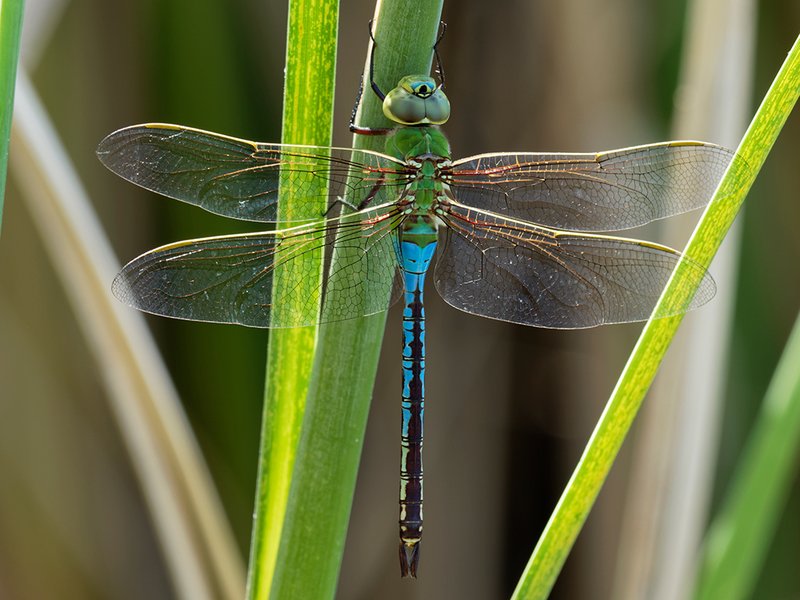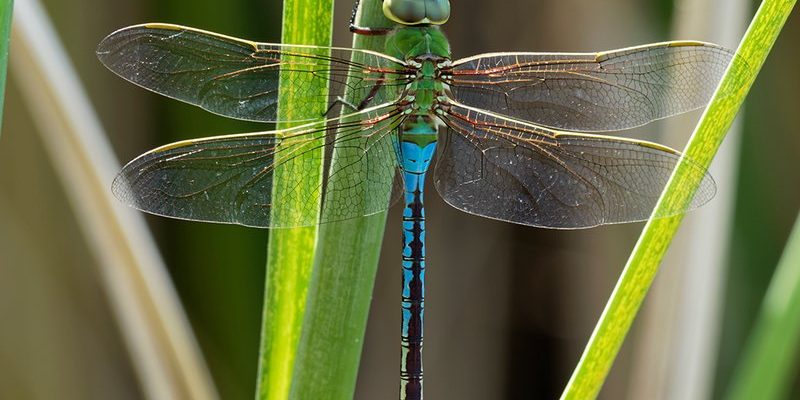
Have you ever spotted a dragonfly darting around a sunny pond, its wings shimmering like jewels in the light? Among these fascinating insects, the Green Darner Dragonfly stands out for its vibrant colors and remarkable hunting skills. Imagine a tiny helicopter whizzing through the air, deftly catching its prey mid-flight. That’s the Green Darner for you—a marvel of nature that’s both beautiful and equipped for survival.
These dragonflies are not just a feast for the eyes; they play a crucial role in their ecosystems, controlling mosquito populations and contributing to the food web. But what makes the Green Darner Dragonfly unique? In this article, we’re diving deep into their world, exploring everything from their physical characteristics to their fascinating behaviors. So, let’s get started!
Physical Characteristics
The Green Darner Dragonfly is easily recognizable due to its striking appearance. It boasts a vibrant green thorax and a blue abdomen, which can grow up to 3 inches in length. This combination of colors not only makes it visually appealing but also helps it blend into the foliage near water bodies. If you’re lucky, you might catch one resting on a branch, showcasing its intricate wing patterns that almost look like stained glass in the sunlight.
One of the most impressive features of the Green Darner is its wings. They can span up to 4 inches, allowing for remarkable agility in the air. Unlike many insects, these dragonflies possess two pairs of wings that can move independently. This means they can hover, fly backward, and make sharp turns with ease. It’s like watching an aerial ballet when they’re on the hunt!
In terms of their body structure, Green Darners have large, multifaceted eyes that provide nearly panoramic vision. This is crucial when they’re on the lookout for prey, as they can spot insects from a good distance. When you see a Green Darner in action, it’s as if nature has designed the perfect predator—fast, agile, and incredibly effective.
Habitat and Distribution
The Green Darner Dragonfly is found throughout North America, from Canada to the southern United States. They are commonly seen near water bodies like ponds, lakes, and marshes. These environments provide the necessary resources for both adult dragonflies and their larvae, which are aquatic and require still or slow-moving water to thrive.
You might be wondering about their migratory behavior. Interestingly, the Green Darner is one of the few dragonfly species that migrates. During the fall, many of them travel south to warmer climates, sometimes crossing vast distances. This migration can be quite a sight to see, as thousands of these dragonflies can gather together, creating a stunning visual display in the sky.
During warmer months, you’ll often find them hovering above water or perched on nearby vegetation. They prefer sunny areas with plenty of open space, allowing them to hunt effectively for insects. If you’re keen on spotting these beauties, your best bet is to visit a local pond or wetland during peak summer months. Just remember to bring your camera—these dragonflies are a sight you won’t want to miss!
Diet and Feeding Habits
When it comes to food, the Green Darner Dragonfly is a true carnivore. Their diet primarily consists of a variety of flying insects, including mosquitoes, flies, and even other dragonflies. Watching them hunt is an exhilarating experience; they employ their incredible speed and precision to capture prey mid-air. You might even see them perform stunning aerial maneuvers while snatching insects from the sky.
These dragonflies are not just hungry for any insect; they are selective eaters and show a preference for rich protein sources. The high protein content helps them grow and reproduce effectively. When a female Green Darner is ready to lay eggs, she needs extra energy, which she gets from consuming nutritious meals during her hunting sessions.
Interestingly, their hunting strategy is quite fascinating. They often perch on plants or rocks, waiting patiently for the right moment to strike. Once they spot a potential meal, they launch into action, showcasing their swift movements. This technique not only makes them efficient hunters but also helps conserve energy over time. In a world where food can be scarce, the Green Darner’s feeding habits keep it thriving.
Life Cycle and Reproduction
The life cycle of the Green Darner Dragonfly is an incredible journey that unfolds over several stages. It begins as an egg, laid in water, where it will hatch into a nymph. These nymphs are aquatic and go through several molts before emerging as adults. This process can take up to a year, depending on the environmental conditions.
Once the nymph is ready to transform, it climbs out of the water and undergoes a remarkable metamorphosis. As the adult dragonfly emerges, it is initially soft and vulnerable, but within a few hours, it dries out and hardens, revealing the stunning colors we associate with this species.
During the reproductive season, male Green Darners engage in some intriguing courtship behaviors. They can be quite territorial, defending their chosen areas from rivals. Once a female is impressed, the duo engages in a distinctive mating flight. After mating, the female lays her eggs in water, ensuring the cycle continues. It’s a beautiful dance of life that highlights the resilience of these remarkable insects.
Conservation Status
As with many species, the Green Darner Dragonfly faces several threats due to changes in their habitats. Factors like urban development, pollution, and climate change can impact their environments, making it essential to monitor their populations closely. While they are currently not listed as endangered, protecting their natural habitats is crucial for their survival.
Conservation efforts are increasingly focusing on preserving wetland areas and promoting biodiversity. By creating more natural habitats and addressing pollution, we can help sustain the populations of Green Darners and other dragonfly species. You can also contribute by creating a bug-friendly garden with native plants that attract these insects.
Awareness is key. By educating others about the importance of dragonflies in our ecosystems, we can foster a greater appreciation for these beautiful creatures. Every small action can lead to significant impacts, and together, we can ensure that the Green Darner Dragonfly continues to thrive in nature.
Interesting Facts
| Scientific Name: | Aeshna platycephala |
| Size: | Up to 3 inches in length |
| Wingspan: | Up to 4 inches |
| Diet: | Insects (mosquitoes, flies) |
| Habitat: | Ponds, lakes, marshes |
| Lifespan: | Approximately 3-5 months as an adult |
| Migration: | Yes, migratory species |
FAQ
What is the average lifespan of a Green Darner Dragonfly?
The average lifespan of a Green Darner Dragonfly as an adult is around 3 to 5 months. However, their nymph stage can last much longer, sometimes up to a year, depending on environmental conditions. The time spent as a nymph is crucial for their growth, as they need to develop before emerging as adults.
Are Green Darner Dragonflies dangerous to humans?
No, Green Darner Dragonflies are not dangerous to humans. They are harmless insects that focus on hunting smaller flying insects. They don’t sting or bite unless provoked, but even then, they are more likely to fly away than to engage in any aggressive behavior. They are beneficial in controlling insect populations and contribute positively to the environment.
How can I attract Green Darner Dragonflies to my garden?
Attracting Green Darner Dragonflies to your garden can be a rewarding experience. To do this, create a water feature like a pond or a small water garden. Adding native plants around the water can provide shade and a place for them to perch. Avoid using pesticides, as they can harm these beneficial insects. A natural habitat will entice Green Darners and other insects to thrive.
Do Green Darner Dragonflies migrate?
Yes, Green Darner Dragonflies are known for their migratory behavior. During the fall, many of them travel south to warmer climates in search of food and suitable breeding conditions. Their migration can cover thousands of miles, and witnessing this phenomenon can be quite a spectacle.
What role do Green Darner Dragonflies play in the ecosystem?
Green Darner Dragonflies play a vital role in their ecosystems by helping control the populations of flying insects, especially mosquitoes. They serve as both predators and prey, contributing to the food web. Their presence indicates a healthy ecosystem, making them important indicators of environmental health.
What do Green Darner Dragonflies eat?
Green Darner Dragonflies primarily feed on other flying insects, including mosquitoes, flies, and even smaller dragonflies. Their hunting skills are impressive, allowing them to catch their prey mid-flight. This diet helps them maintain energy levels for growth and reproduction.
How can I identify a Green Darner Dragonfly?
To identify a Green Darner Dragonfly, look for its distinctive green thorax and blue abdomen. They are among the larger dragonflies, typically measuring 3 inches in length with a wingspan of about 4 inches. Their large, multifaceted eyes and unique wing patterns also help in identification. Spotting them near ponds or marshes during warm months is a good bet.
Are Green Darner Dragonflies solitary or social insects?
Green Darner Dragonflies are generally solitary creatures. While they may be seen in groups during certain times of the year, particularly during migration, they tend to be territorial and often engage in aggressive behaviors to defend their hunting grounds from other males. This solo lifestyle aids in their hunting efficiency.

